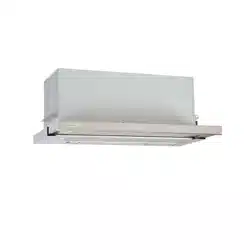Loading ...
Loading ...
Loading ...

- 9 -
FIGURE 10
MAINTENANCE
Proper maintenance of the Range Hood
will assure proper performance of the unit.
BEFORE SERVICING OR CLEANING
UNIT, SWITCH POWER OFF AT SER-
VICE PANEL AND LOCK SERVICE DI-
SCONNECTING MEANS TO PREVENT
POWER FROM BEING SWITCHED ON
ACCIDENTALLY.
WHEN THE SERVICE DISCONNEC-
TING MEANS CANNOT BE LOCKED,
SECURELY FASTEN A PROMINENT
WARNING DEVICE, SUCH AS A TAG,
GREASE FILTERS
TO THE SERVICE PANEL.
Grease fi lters
The grease fi lters should be cleaned periodically depending upon use (appro-
ximately every two (2) months).
Use a warm detergent solution. Grease fi lters are dishwasher safe.
Clean all-metal
fi lters in the dishwasher using a non-phosphate detergent. Discoloration of the fi lter
may occur if using phosphate detergent or as a result of local water conditions — but
this will not aff ect fi lter performance. This discoloration is not covered by the warranty.
To remove the grease fi lters, push the retainer near the handle inwards and pull
the fi lter downwards (Fig. 10); open the holder and remove the other fi lter in the
same way.
Charcoal Filters
The charcoal fi lters should be changed every 6 months. Rotate the fi lters to remove
and replace.
Hood Cleaning
Stainless steel is one of the easiest materials to keep clean. Occasional care will
help preserve its fi ne appearance.
Cleaning tips:
• Hot water with soap or detergent is all that is usually needed.
• Follow all cleaning by rinsing with clear water. Wipe dry with a clean, soft cloth
to avoid water marks.
• For discolorations or deposits that persist, use a non-scratching household
cleanser or stainless steel polishing powder with a little water and a soft cloth.
• For stubborn cases, use a plastic scouring pad or soft bristle brush together with
cleanser and water. Rub lightly in direction of polishing lines or “grain” of the
stainless fi nish. Avoid using too much pressure which may mar the surface.
• DO NOT allow deposits to remain for long periods of time.
• DO NOT use ordinary steel wool or steel brushes. Small bits of steel may adhere
to the surface causing rust.
• DO NOT allow salt solutions, disinfectants, bleaches, or cleaning compounds
to remain in contact with stainless steel for extended periods. Many of these
compounds contain chemicals which may be harmful. Rinse with water after
exposure and wipe dry with a clean cloth.
• Surfaces should be cleaned with warm water and mild detergent only.
Loading ...
Loading ...
Loading ...
